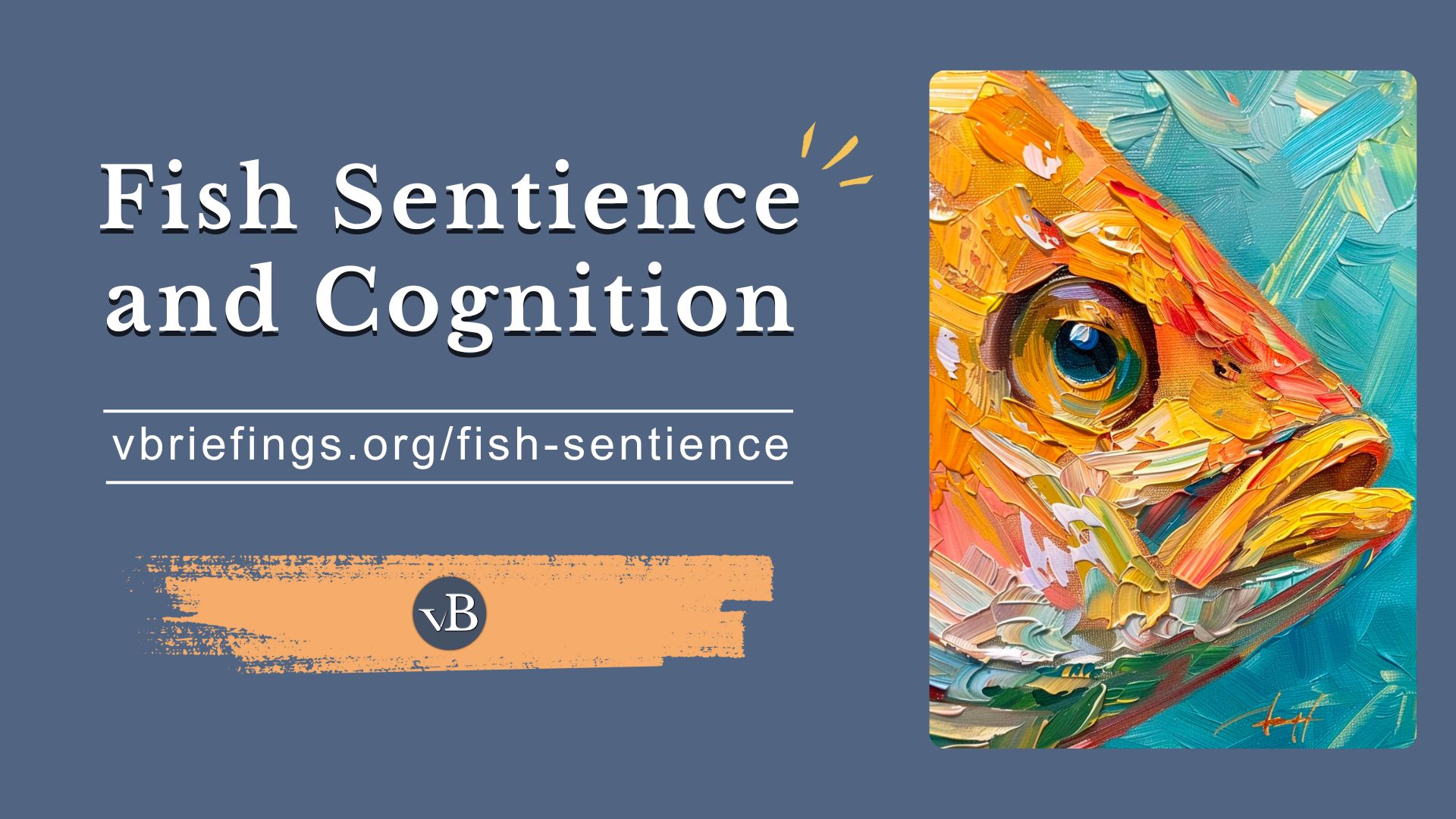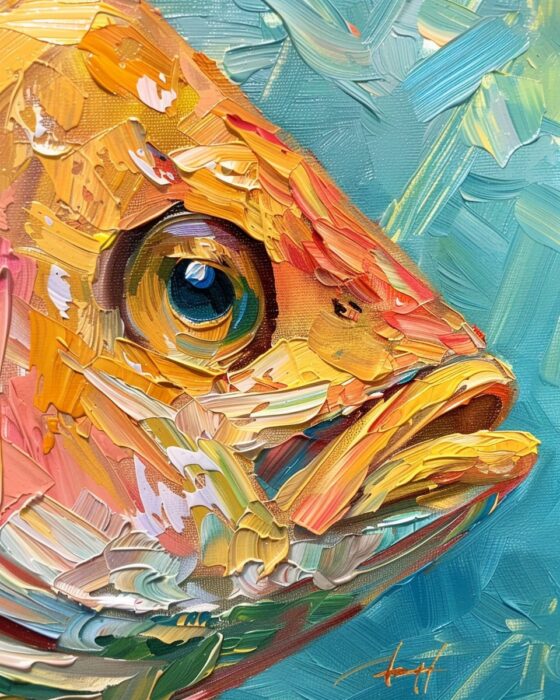Preface
Briefing description and more.
This briefing provides scientific evidence that fish feel pain, are sentient, and lead rich cognitive, emotional, and psychological lives. It also includes slaughter counts.
Companion Videos
How to use companion videos
Videos may be posted on multiple social media platforms, and you can share them on each platform according each platform’s conventions.
Share this Briefing
Social Media Sharing Image
This image will be used when sharing the briefing on a social media platform. You can see all social sharing images in the grid view.

How to share this briefing
Click on the icon for the platform on which you wish to share. What happens next depends on the platform, but generally a popup will appear, letting you add your own text as you share.
Briefing Meta
Metrics
Note: we will publish additional briefings after completing flashcards and presentation slides for selected briefings.
Counts:
| Main Text | |
| Key Points | 6 |
| Counterclaims | 1 |
| Supplementary | 1 |
| Further Study | 5 |
| Footnotes | 25 |
| Media & Advocacy | |
| Advocacy Notes | 13 |
| —Socratic Questions | 18 |
| Flashcards | 39 |
| Presentation Slides | 0 |
| Memes & Infographics | 0 |
| Companion Videos | 0 |
Other Meta:
Date Posted:
Last Edited:
Edit Log:
Key Points Links
Loading…
Help Us Improve
Please send your suggestions for improvements, or report any issues with this briefing to team@vbriefings.org
We appreciate that you are taking the time to help up improve. All suggestions and reports will be carefully considered.
Summary
A concise summary of the briefing (see below for citations).
Fish are sentient beings with the ability to feel pain, experience emotions, and lead cognitively rich lives, as evidenced by studies and scientists, who show that fish perceive pain similarly to mammals and birds. Their complex behaviors, including learning, memory, and anticipating future events, reveal advanced cognitive and emotional capacities. Additionally, their ability to experience fear and stress highlights their sophisticated neurological structures, underscoring the depth of their emotional and cognitive lives.
Context
Places this topic in its larger context.
Sentience is the capacity to feel pain and experience emotions. It is significant because it serves as the criterion for determining whether living beings deserve moral consideration.
While sentient beings have differing levels of intelligence, these differences in intelligence are not morally relevant, as discussed in our briefing on animal rights.
Key Points
This section provides talking points.
Fish feel pain.
Marc Bekoff, perhaps the world’s leading cognitive ethologist, having written over 30 books and hundreds of essays on animals1, says that “fish are sentient and emotional beings and clearly feel pain.“2
An article published in the Smithsonian Magazine titled “It’s Official: Fish Feel Pain” pointed to numerous compelling studies showing strong evidence that fish feel pain.3
The American Veterinary Medical Association, which in no way could be considered an animal rights organization because of its close ties with the animal agriculture industry4, said that “finfish should be accorded the same considerations as terrestrial vertebrates in regard to relief from pain.”5
According to Victoria Braithwaite, professor of Fisheries and Biology at Penn State University, fish do feel pain. She also stated that “Fish, like birds and mammals, have a capacity for self-awareness.”6
According to Donald Broom, Emeritus Professor of Animal Welfare at the University of Cambridge, “the evidence of pain system and fear system function in fish is so similar to that in humans and other mammals that it is not logical to conclude that fish cannot feel pain.””7
Marquette Natural Sciences professor Culum Brown and coauthor of the book Fish Cognition and Behavior8, says that “fish experience pain in a manner similar to the rest of the vertebrates.”9
Fish display emotions.
Marc Bekoff, perhaps the world’s leading cognitive ethologist, having written over 30 books and hundreds of essays on animal behavior, says that “fish are sentient and emotional beings and clearly feel pain.”10
Ethologist Dr. Jonathan Balcombe, in one of his 6 books on animal behavior, What a Fish Knows, shows overwhelming evidence that fish are intelligent, feel pain, display emotions, and have many of the other characteristics of the land animals we use for food. 11
Fish cognition can match or exceed other vertebrates.
Fish have a sense of themselves and a sense of the future.
Victoria Braithwaite, professor of Fisheries and Biology at Penn State University, says that “fish, like birds and mammals, have some capacity for self-awareness.” 14
Fish avoid areas where they have previously had negative experiences, showing that they are able to anticipate the same thing happening in the future15
Fish can experience fear and stress.
A scientific panel commissioned by the European Commission concluded:
- Fish are able to experience fear, pointing out that fear is useful for defense and escape.
- The stress physiology of fish is “directly comparable to that of higher vertebrates.”
- When exposure to stress is prolonged, it can become chronic and affect the immune system and growth, and may even cause death.16
Fish have long-term memory and can learn.
A paper published in the Fish and Fisheries Journal identified several studies showing that fish learn skills from one another, including:
- predator avoidance,
- migration routes,
- food location,
- eavesdropping,
- and how to choose a mate.17
Common carp remember and learn from a hooking experience for 14 months, helping them to avoid a repeat experience.18
The ability to learn shows that fish possess and use long-term memory.19
Counterclaims
Responses to some yes but retorts.
Claim: Because fish lack a neocortex, they are incapable of suffering.
Birds and amphibians are known to suffer and feel pain despite not having a neocortex. As a result, it is not reasonable to conclude that fish do not experience pain or suffering based on their brain structure.20
Though the brain structure of fish differs from that of mammals, it performs similar functions. Fish possess both an amygdala and a hippocampus, regions of the brain that deal with learning, emotion, and memory.21
Supplementary Info
Additional information that may prove useful.
Further Study
Sources providing a deeper understanding of the topic or related topics.
Other Resources
The website Fish Feel educates the public about fish intelligence and emotional capacity, advocates for their welfare, and raises awareness about the exploitation of fish in various industries.
The Smithsonian Magazine article, “It’s Official: Fish Feel Pain.” presents the scientific evidence that fish can feel pain and discusses the potential ethical implications of this understanding
The Youtube Video “What Fish Feel When They Are Killed for Food” presents evidence and arguments supporting the idea that fish can feel pain, challenging the common belief that they cannot, and explores the ethical implications of this understanding for how we treat fish.
The Youtube video “The VET Talks – Can Fish Feel Pain?” presents scientific evidence that fish have the necessary neurological structures and exhibit behaviors indicating they can experience pain. The presentation is by Dr. Lysa Posner, DVM, DACVAA, Associate Professor of Anesthesiology – North Carolina State University College of Veterinary Medicine (Raleigh, NC, USA).
Advocacy Resources
Information to help with outreach and advocacy.
Note: we will publish additional briefings after completing flashcards and presentation slides for selected briefings.
Share This Briefing
Cloned from the Preface Section on page load.
Companion Videos
Cloned from the Preface Section on page load.
Memes and Infographics
No images found.
How to use Memes and Infographics
To sequence through all memes and infographics on this page, click on any image than use the arrow keys or the arrow buttons to show next and previous images.
To share a meme or infographic, right click on the image and choose download or save as. Then upload the image to the platform of choice.
Presentation Slides
Slides not available.
How to Use the Presentation Slides
You can view the slideshow full screen by clicking on the first link above.
To use Canva presenter mode, view the speaker notes, or download the slides as PowerPoint, login to Canva (the free account works) and follow the Full Canva Link provided above.
To copy this presentation to your own Canva project, use the Full Canva Link provided above, then select File->Make a Copy from the upper left. You can build your own unique presentation from multiple briefings by copying the presentation from each briefing and then building another presentation from the copied presentations.
Flash Cards
We partner with Brainscape because of their excellent features for learning. You will need to create a free Brainscape account to study the cards.
Go to Flash Cards: This will take you to a list of decks.
About Flash Cards and Brainscape
Flash cards are here to help you commit important facts and concepts in this briefing to memory.
In Brainscape, there is one deck for each briefing. You can study more than one deck at a time. Brainscape uses spaced repetition to promote memory retention. It is “the secret to learning more while studying less.”
You can study using your browser, but Brainscape also has a free mobile app that makes learning anywhere easy.
Socratic Questions
Socratic-style questions are embedded in the Advocacy Notes below, and shown in italics.
These are open-ended, thought-provoking questions designed to encourage critical thinking, self-reflection, and deeper understanding. They are inspired by the Socratic method, a teaching technique attributed to the ancient Greek philosopher Socrates, who would ask his students probing questions rather than directly providing answers.
The goal is to help people examine their beliefs, clarify their thoughts, uncover assumptions, and explore the evidence and reasoning behind their ideas.
Advocacy Notes
Tips for Advocacy and Outreach
General Tips
Whenever you mention cows, pigs, and chickens as subjects of exploitation, try and remember to add fish to that list.
If someone accepts that fish are sentient and worthy of moral consideration, then it will likely follow for them that other vertebrates such as pigs, cows, and chickens are also sentient.
As always, if you are asked for the sources and can’t be specific, then say they’re from various studies and the citations are available at the vbriefings.org post on fish sentience.
Finally,
- Make it personal. Help them connect with their own experiences rather than just hearing facts.
- Challenge their assumptions. Get them to examine their biases rather than just rejecting the idea outright.
- Ask, don’t just tell. Thought-provoking questions stick with people longer than statistics.
Connect the Suffering to Purchasing Decisions
When discussing animal suffering with someone, the goal is to help them recognize that their purchasing choices directly contribute to that suffering. Many people compartmentalize their role in the system, seeing the harm as something “out there” rather than something they are personally involved in. By asking thought-provoking questions, we encourage them to take responsibility for their choices.
- “Since most people don’t kill fish themselves, the suffering happens out of sight. But do you think purchasing fish absolves us of culpability for what happens to them?”
- “When we buy fish, we’re subsidizing the industries that breed, catch, and kill them. Wouldn’t you say that our purchases directly contribute to their suffering?”
- “If we already know fish suffer, and we don’t need to eat them to be healthy, what’s the justification for purchasing their corpses?”
- “If demand for fish products declined, do you think fewer fish would be farmed, netted, and slaughtered?”
- “The same is true for chickens, cows, and pigs. If we recognize our culpability for suffering in purchasing fish, doesn’t it follow that buying meat, eggs, or dairy has the same effect?”
- “If we can meet our nutritional needs without buying products that cause suffering, wouldn’t the most ethical choice be to stop purchasing them?”
Why? It ties suffering back to their own purchases and makes it personal.
Don’t Let People Dismiss Fish—Make It Personal
People often devalue fish because they seem too different from us. Instead of jumping straight into facts, get them to reflect on their own experiences.
- “Have you ever seen a fish struggle on a hook or gasp for air out of water? If they didn’t feel anything, why would they react like that?”
- “If fish didn’t feel pain, why do they try to escape when caught? Why do they avoid places where they’ve had bad experiences?”
Why? This makes the suffering of fish visceral and real rather than just theoretical.
Redirect the Focus to Science
Many people assume fish don’t feel pain simply because they haven’t been exposed to the evidence.
- “Scientific studies show that fish have pain receptors, stress responses, and even avoid places where they’ve been hurt before—just like mammals. Why do you think so many scientists agree that fish feel pain?”
Why? This challenges them to rethink their bias toward land animals.
Use a Moral Consistency Check
People often draw arbitrary lines about which animals deserve compassion. Push them to justify their reasoning.
- “If a dog was gasping for air, most people would rush to help. Why do we see a suffocating fish as just ‘normal fishing’?”
- “If intelligence were the deciding factor for moral consideration, where would that leave babies or people with cognitive disabilities?”
- “If fish suffer when they’re pulled from the water, suffocate, or are cut open alive, does that suffering hold moral weight?”
Why? This forces them to confront their own inconsistencies rather than just dismissing fish.
Flip the Burden of Proof
Some people will say, “You can’t prove fish feel pain.” The truth is, they can’t prove the opposite—and the scientific consensus is already in favor of fish sentience.
- “There’s more evidence that fish feel pain than there is for many things we take for granted. Wouldn’t it make sense to err on the side of caution?”
- “If we waited for absolute proof before acting, would we also ignore suffering in other animals just because we haven’t studied it enough?”
Why? This shifts the burden back onto them instead of you constantly defending your position.
Make the Scale of Suffering Impossible to Ignore
Many people don’t realize how many fish are killed every year. Numbers this big make it clear that the issue is massive, not trivial.
- “Did you know that humans kill trillions of fish per year—far more than all land animals combined? Does that sound like an issue worth ignoring?”
- “When you hear about animal suffering, most people think of cows, pigs, and chickens. Why do you think we leave out the trillions of fish who suffer just as much?”
Why? This helps them see how overlooked fish suffering really is.
Get Them to Think About Individual Fish, Not Just Numbers
Large numbers can feel too abstract for people to care about. Make fish suffering relatable by talking about their behavior.
- “Some fish build nests, use tools, and have long-term memory. Does that sound like a mindless creature to you?”
- “There are fish who recognize individuals, hold grudges, and even learn from each other. If a dog did that, we’d call it intelligence. Why ignore it in fish?”
Why? This humanizes fish, making it harder to dismiss them.
Footnotes
Our sources, with links back to where they are used.
- Ahmad, Qirrat. “Every Life Matters.” Earth Island Journal, 2018. Accessed 13 Nov. 2024. ↩︎
- Bekoff, Marc. “Fish Are Sentient and Emotional Beings and Clearly Feel Pain.” Psychology Today, June 19, 2014. ↩︎
- Ferris Jabr and Hakai Magazine. “It’s Official: Fish Feel Pain.” January 8, 2018. Smithsonian Magazine. ↩︎
- “Animal Agriculture Liaison Committee.” American Veterinary Medical Association, 2024. Accessed 13 Nov. 2024. ↩︎
- Leary, Steven L, and American Veterinary Medical Association. “AVMA Guidelines for the Euthanasia of Animals: 2020 Edition.” 2020. ↩︎
- Braithwaite, Victoria. Do Fish Feel Pain? Oxford ; New York: Oxford University Press, 2010. 183, 134-35. ↩︎
- Broom, Donald. “Fish Brains and Behaviour Indicate Capacity for Feeling Pain.” Animal Sentience Journal. 2016. ↩︎
- Culum Brown, Kevin Laland, and Jens Krause. Fish Cognition and Behavior, 2nd Edition. Wiley Publishing, 2011 ↩︎
- Brown C. Fish intelligence, sentience and ethics. Anim Cogn. 2015 Jan;18(1):1-17. Epub 2014 Jun 19. PMID: 24942105 ↩︎
- Bekoff, Marc. “Fish Are Sentient and Emotional Beings and Clearly Feel Pain.” Psychology Today, June 19, 2014. https://www.psychologytoday.com/us/blog/animal-emotions/201406/fish-are-sentient-and-emotional-beings-and-clearly-feel-pain ↩︎
- Balcombe, Jonathan. What a Fish Knows: The Inner Lives of Our Underwater Cousins. Scientific American / Farrar, Straus and Giroux, 2016. 74. ↩︎
- Culum Brown, Kevin Laland, and Jens Krause. Fish Cognition and Behavior, 2nd Edition. Wiley Publishing, 2011 ↩︎
- Brown, C. Fish intelligence, sentience and ethics. Anim Cogn. 2015 Jan;18(1):1-17. Epub 2014 Jun 19. PMID: 24942105 ↩︎
- Braithwaite, Victoria. Do Fish Feel Pain? Oxford ; New York: Oxford University Press, 2010. 134-135 ↩︎
- Csányi, Vilmos, and Antal Dóka. “Learning Interactions between Prey and Predator Fish.” Marine Behavior and Physiology 23, no. 1–4 (October 1993): 63–78. ↩︎
- Algers, Bo et al. “General Approach to Fish Welfare and to the Concept of Sentience in Fish.” EFSA Journal 7, no. 2 (2009). ↩︎
- Brown, Culum, and Kevin N. Laland. “Social Learning in Fishes: A Review.” Fish and Fisheries 4, no. 3 (September 2003): 280–88. ↩︎
- Czapla, Philipp. “Long-Term Hook Avoidance of Common Carp (Cyprinus Carpio) as a Function of Private and Social Cues | Ifishman.de.” Ifishman.de, 2021. Accessed 30 Dec. 2024. ↩︎
- Odling-Smee, Lucy, and Victoria A Braithwaite. “The Role of Learning in Fish Orientation.” Fish and Fisheries 4, no. 3 (September 2003): 235–46. ↩︎
- Cooke, Steven J., and Lynne U. Sneddon. “Animal Welfare Perspectives on Recreational Angling.” Applied Animal Behavior Science 104, no. 3–4 (May 2007): 176–98. ↩︎
- Stockinger, Günther. “The Hook That Hurts: Scientists Tip the Scales Against Anglers.” Spiegel Online, March 11, 2011, sec. International ↩︎
- Estimated numbers of individuals in annual global capture tonnage via FAO FishStat “Capture Production 1950-2016” (Release Date: 15th March 2018) ↩︎
- Sept 2019. A Mood and P Brook. Estimated numbers of individuals in global aquaculture production. (FAO) Sept 2019. ↩︎
- Estimated numbers of individuals in average annual fish capture (FAO) by country fishing fleets from FAO FishStat “Capture Production 1950-2016. 15th March 2018”. ↩︎
- A Mood and P Brooke. Estimated numbers of individuals in aquaculture production of fish species. (FAO). Sept 2019 ↩︎




